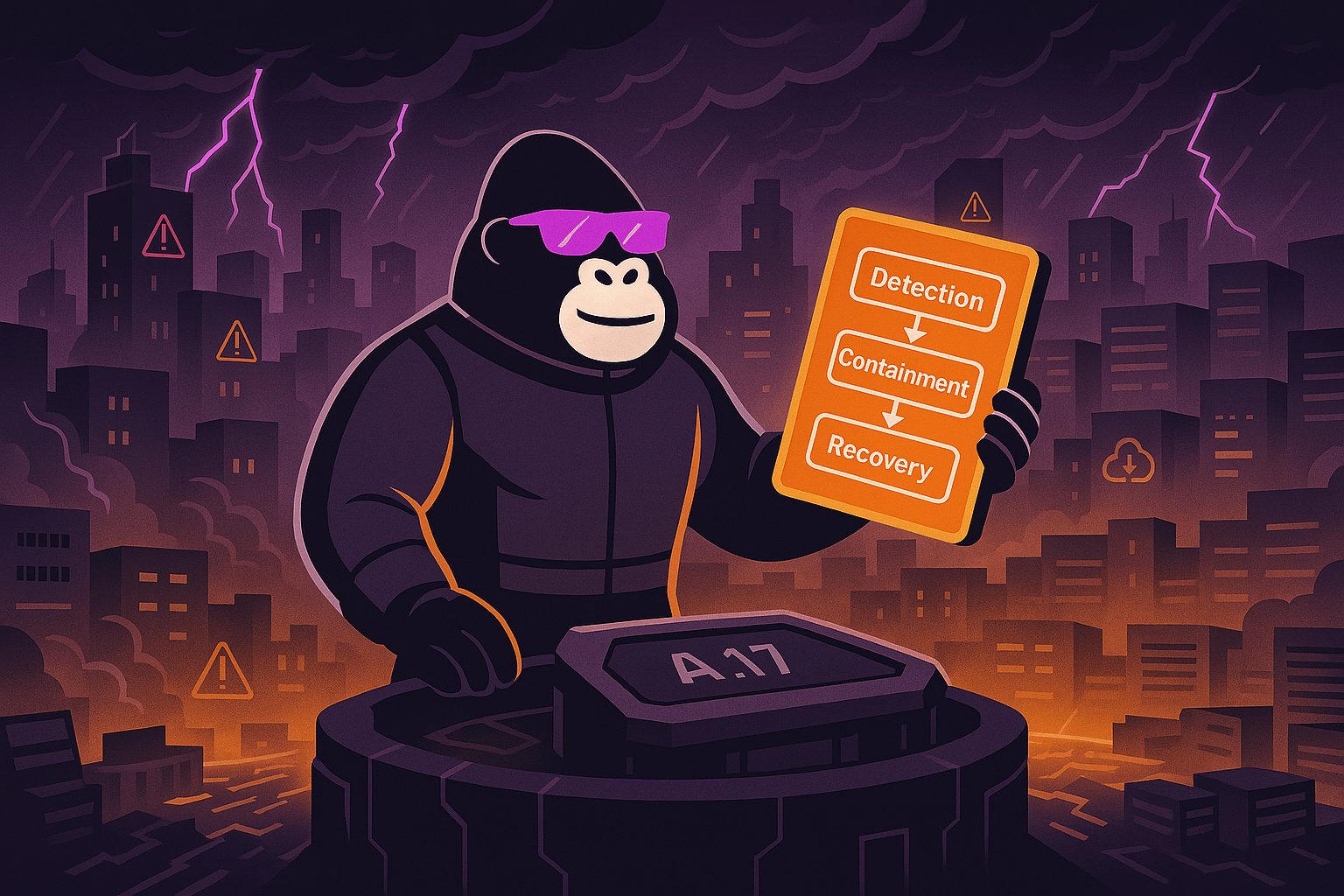It wasn’t the fire alarm or even the smell of smoke that raised the most panic—it was the sudden realization that the servers hadn’t been backed up offsite in over two weeks. That gut-punch moment of dread is one too many IT managers and compliance officers know intimately. In the world of digital infrastructure, disaster rarely sends a calendar invite. But when it strikes, your response—or lack thereof—can define your organization’s future.
If you’re new to the idea of aligning your recovery protocols with ISO 27001 disaster recovery requirements, you’re not alone. This guide breaks down the essentials in a practical, experience-based way. We’ll look at how to navigate the standard, design a compliant recovery process, and use strategic documentation—like flowcharts and testing schedules—to stay ahead of the unexpected.
Understanding the role of disaster recovery in ISO 27001
The ISO/IEC 27001 standard is fundamentally about information security. But many newcomers are surprised to find how central disaster recovery standards are to achieving and maintaining certification. Disaster recovery isn’t just a reactive protocol—it’s an essential part of an organization’s Business Continuity Planning (BCP) and a control required under Annex A.17 of the ISO 27001 framework.
The goal? To ensure availability of information in the face of disruptive incidents. Whether it’s a cyberattack, flood, ransomware event, or good old-fashioned hardware failure, you’re expected to demonstrate that systems can be restored within acceptable timeframes.
The clause that drives this home most clearly is A.17.1, which covers information security continuity. Organizations must define requirements for information availability, and develop plans, procedures, and mechanisms to ensure restoration after a disruption.
Let’s take a closer look at what that actually means in practical terms.
| Clause number | Description | Relevance to disaster recovery |
| A.17.1.1 | Planning information security continuity | Requires defined continuity plans and recovery strategies |
| A.17.1.2 | Implementing continuity procedures | Ensures procedures are in place to recover information systems |
| A.17.1.3 | Verifying and reviewing continuity | Mandates regular testing and updates to recovery plans |
| A.17.2.1 | Redundancies | Requires system design that supports continuity, e.g., failovers |
These controls aren’t just checkboxes. They shape how you document, simulate, and review your recovery strategies.
PRO TIP
When defining information availability requirements, involve both IT and business unit leads. Legal and marketing may have wildly different tolerances for downtime—capturing those variances up front prevents RTOs that collapse under real pressure.
What a disaster recovery plan actually looks like
After sitting through more than a few ISO 27001 audits, I’ve learned that disaster recovery plans (DRPs) vary wildly between organizations. But the most successful ones have a few critical components in common: clarity, alignment with business objectives, and regular testing.
A DRP should document the steps needed to restore IT systems and data following a disruption. It’s not the same as a full business continuity plan—though the two are closely related. Your DRP is focused specifically on technology assets: servers, storage, networks, and data.
| Component | Purpose | Common pitfalls |
| Recovery Time Objective (RTO) | Maximum allowable downtime for systems | Unrealistic timelines due to poor testing |
| Recovery Point Objective (RPO) | Maximum data loss measured in time | Misaligned with backup frequency |
| Asset Inventory | List of systems, apps, and data requiring recovery | Often outdated or incomplete |
| Communication Plan | Defines roles and messages during incidents | Lacks clarity on external vs. internal communications |
| Test Schedule | Planned exercises to validate DRP | Treated as a checkbox, not a learning opportunity |
The effectiveness of a DRP depends on how well these elements are tailored to your actual infrastructure and business risks. If you’re unsure where to start, ISO’s own documentation on management system standards offers foundational guidance, though it’s a bit dense for first-timers.
PRO TIP
Make your asset inventory a shared responsibility. Assign owners per system and automate updates via CMDB or asset discovery tools—an outdated inventory is one of the most common audit flags and recovery blockers.
Visualizing disaster recovery: flowcharts and logic maps
When disaster strikes, cognitive overload is real. That’s why visual aids like flowcharts are more than helpful—they’re essential. A well-designed disaster recovery flowchart gives teams a single source of truth in high-pressure situations, showing what to do, when, and who is responsible.
In my experience, flowcharts that combine system triggers (e.g., alert from a monitoring tool) with human responses (e.g., escalation to IT lead) reduce decision bottlenecks dramatically.
Here’s an example of a typical structure.
| Phase | Trigger/Event | Action |
| Detection | System anomaly or outage alert | Notify IT and activate DRP |
| Assessment | Determine impact on services/data | Classify incident severity |
| Containment | Prevent further damage | Isolate affected systems |
| Recovery | Restore from backup or failover systems | Monitor for stability |
| Review | Conduct post-mortem | Update DRP based on findings |
A simple flowchart based on this table can help translate your DRP into something operational. Tools like Lucidchart or Draw.io are great for building these visuals, and many auditors appreciate seeing them alongside textual policies.
PRO TIP
Keep a laminated “grab chart” version of your DRP flowchart in your server rooms or network closets. If your systems are down, your documentation shouldn’t be.
Testing, revising, and proving compliance
Writing a DRP is just the beginning. ISO 27001 requires that you test your plan—not once, but regularly. Testing does more than satisfy auditors; it builds confidence in your team and highlights flaws before they cost you.
I’ve worked with teams who thought their plan was bulletproof, only to discover during testing that a recovery server had been misconfigured for months. Others learned that key personnel didn’t even know where the DRP was stored.
Frequency of testing should depend on your business model, but a common baseline is biannual simulations with quarterly checks on backups and configurations.
| Test type | Description | Best use case | Drawback |
| Tabletop exercise | Scenario-based discussion around DRP | Early-stage or low-risk environments | Lacks technical realism |
| Walkthrough | Step-by-step rehearsal of DRP actions | Team training, knowledge gaps | Can miss performance issues |
| Simulation test | Replicates real disaster conditions | Validates technical recovery | Resource-intensive |
| Full interruption | Shuts down systems to test full recovery | High-maturity, low-risk tolerance | Risky without proven DRP |
Organizations should also retain evidence of testing—logs, results, and lessons learned. This is key for ISO audits, especially when aiming to meet broader disaster recovery standards such as those covered in NIST SP 800-34 or ITIL.
PRO TIP
After each test, hold a 15-minute “DR debrief” with all participants. Use three simple prompts: What worked? What didn’t? What next? Capture this in your audit log and use it to refine both procedures and training.
Where to go from here
Disaster recovery isn’t glamorous. It rarely wins awards or gets you praise—until the day it saves your business. That’s why embedding recovery into your ISO 27001 strategy is about more than compliance. It’s about resilience.
If you’re just starting out, don’t worry about building a perfect plan overnight. Focus instead on understanding your infrastructure, defining clear roles, and documenting recovery steps in a way that even someone unfamiliar with your systems could follow.
And most importantly, test. Then revise. Then test again.
How CyberUpgrade simplifies disaster recovery for ISO 27001
Disaster recovery shouldn’t begin with panic. With CyberUpgrade, you don’t just write a DRP—you embed it into daily operations. Our platform automates ISO 27001-aligned disaster recovery workflows, guiding your team through asset mapping, risk-based RTO/RPO settings, and system restoration steps tailored to your infrastructure. No more disjointed spreadsheets or dusty binders—everything is centralized, version-controlled, and audit-ready.
When disaster strikes (or testing day arrives), our chatbot on Slack or Teams alerts your team, collects evidence, and ensures role-specific actions are followed step-by-step. You get real-time visibility into testing logs, simulation outcomes, and system health—making your DRP a living, verifiable process.
And with fractional CISOs by your side, you’ll craft a strategy that meets both the letter and spirit of ISO 27001 Annex A.17. From designing flowcharts to orchestrating cross-functional tests, we turn recovery planning into a resilience advantage—not just a checkbox.
Are you testing for recovery—or just hoping for the best?
Aligning with ISO 27001 disaster recovery expectations means adopting a mindset of continuous improvement. Treat each disruption or test not as a pass/fail exercise, but as a learning opportunity. Your future self—and your auditors—will thank you for it.
For more detail on setting up your compliance infrastructure, check out this resource from IT Governance or the official ISO 27001 control framework.
Let this guide be your launching pad. The real work begins with the next incident you prevent.









